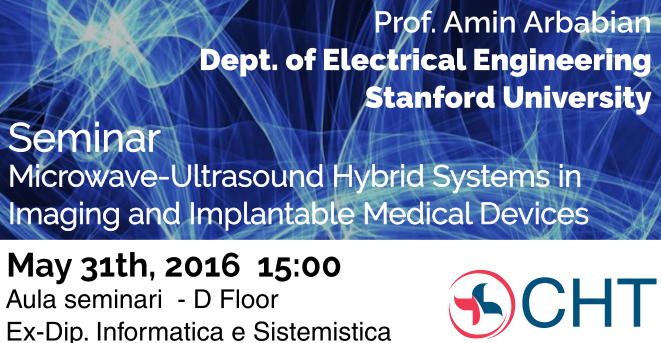
Title:
Microwave-Ultrasound Hybrid Systems in Imaging and Implantable Medical Devices
Speaker:
Prof.Armin Arbabian
Dept. of Electrical Engineering Stanford University
Abstract:
Our group works on the design of new medical devices and concepts that combine advanced electronics with new physical interactions to address challenges in imaging‚ sensing‚ and implantable devices. This talk will focus on two of the active areas: i) bedside medical imaging with portable and low-cost systems‚ and ii) minimally-invasive implantable medical devices (IMDs) for monitoring and modulating local physiology. The first part of the talk focuses on medical imaging. Conventional imaging modalities (MRI‚ PET‚ CT) rely on expensive and bulky hardware that limit usage to hospitals and clinics. In addition to access‚ safety is a concern with the majority of the imaging techniques and poses a major challenge for frequent screening application (e.g.‚ breast cancer screening). This talk will cover hybrid imaging techniques that combine RF/Microwave with ultrasound to provide high-resolution imaging of dielectric contrasts created by hemorrhages or by tumor angiogenesis and necrotic cores. Additionally‚ a new non-contact imaging technology that can be used for remote interrogation of hidden/embedded objects in highly dispersive media‚ with applications in security and medical screening‚ will be presented. The second part of the talk focuses on implantable medical devices (IMDs)‚ and the fundamental challenges related to the miniaturization of smart and minimally invasive IMDs. I will briefly discuss the design of a system that pushes dimensions down to the mm and sub-mm regime while maintaining the capacity to perform advanced and multi-modal closed-loop monitoring and stimulation
Bio:
Amin Arbabian received his Ph.D. degree in EECS from UC Berkeley in 2011. In 2012 he joined Stanford University, as an Assistant Professor of Electrical Engineering, where he is also a School of Engineering Frederick E. Terman Fellow. In 2007 and 2008, he was part of the initial engineering team at Tagarray, Inc. He spent summer 2010 at Qualcomm’s Corporate R&D division designing circuits for next generation ultra-low power wireless transceivers. Amin’s research interests are in high-frequency circuits, systems, and antennas, medical imaging, and ultra-low power sensors. He currently serves on the TPC for the European Solid-State Circuits Conference and the Radio-Frequency Integrated Circuits (RFIC) Symposium. Prof. Arbabian is the recipient/co-recipient of the 2015 NSF CAREER award, 2014 DARPA Young Faculty Award (YFA), 2013 IEEE International Conference on Ultra-Wideband (ICUWB) best paper award, 2013 Hellman Faculty Scholarship, 2010 IEEE Jack Kilby Award for Outstanding Student Paper at the International Solid-State Circuits Conference, two time second place Best Student Paper Awards at 2008 and 2011 RFIC symposiums, the 2009 CITRIS (Center for Information Technology Research in the Interest of Society at UC Berkeley) Big Ideas Challenge Award and the UC Berkeley Bears Breaking Boundaries award, and the 2010-11 as well as 2014-15 Qualcomm Innovation fellowships.